Haoran Xie
Wavelet-guided Misalignment-aware Network for Visible-Infrared Object Detection
Jul 27, 2025Abstract:Visible-infrared object detection aims to enhance the detection robustness by exploiting the complementary information of visible and infrared image pairs. However, its performance is often limited by frequent misalignments caused by resolution disparities, spatial displacements, and modality inconsistencies. To address this issue, we propose the Wavelet-guided Misalignment-aware Network (WMNet), a unified framework designed to adaptively address different cross-modal misalignment patterns. WMNet incorporates wavelet-based multi-frequency analysis and modality-aware fusion mechanisms to improve the alignment and integration of cross-modal features. By jointly exploiting low and high-frequency information and introducing adaptive guidance across modalities, WMNet alleviates the adverse effects of noise, illumination variation, and spatial misalignment. Furthermore, it enhances the representation of salient target features while suppressing spurious or misleading information, thereby promoting more accurate and robust detection. Extensive evaluations on the DVTOD, DroneVehicle, and M3FD datasets demonstrate that WMNet achieves state-of-the-art performance on misaligned cross-modal object detection tasks, confirming its effectiveness and practical applicability.
Semantic-preserved Augmentation with Confidence-weighted Fine-tuning for Aspect Category Sentiment Analysis
Jun 08, 2025
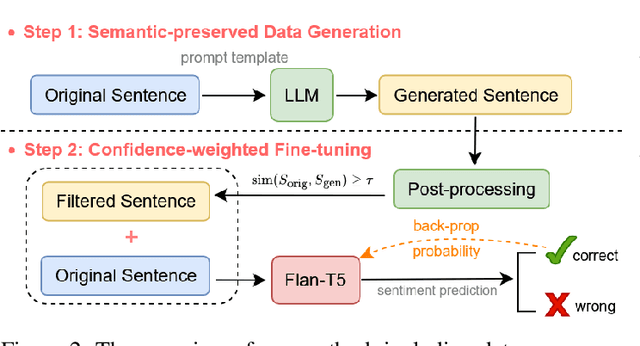
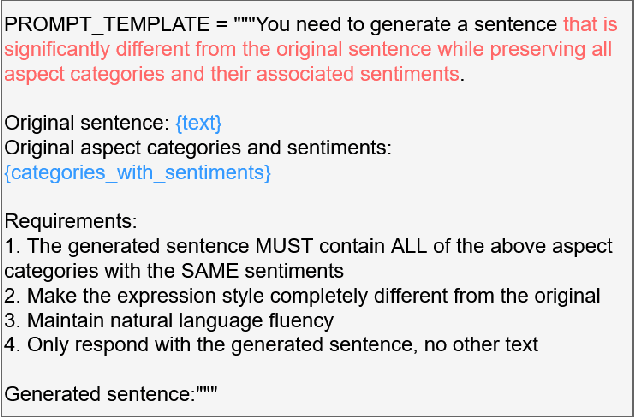
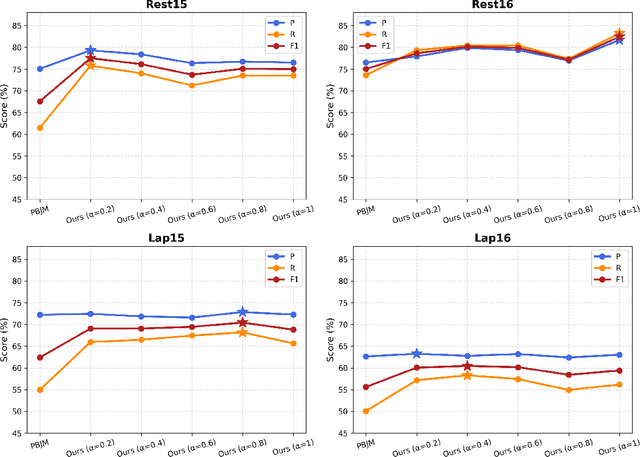
Abstract:Large language model (LLM) is an effective approach to addressing data scarcity in low-resource scenarios. Recent existing research designs hand-crafted prompts to guide LLM for data augmentation. We introduce a data augmentation strategy for the aspect category sentiment analysis (ACSA) task that preserves the original sentence semantics and has linguistic diversity, specifically by providing a structured prompt template for an LLM to generate predefined content. In addition, we employ a post-processing technique to further ensure semantic consistency between the generated sentence and the original sentence. The augmented data increases the semantic coverage of the training distribution, enabling the model better to understand the relationship between aspect categories and sentiment polarities, enhancing its inference capabilities. Furthermore, we propose a confidence-weighted fine-tuning strategy to encourage the model to generate more confident and accurate sentiment polarity predictions. Compared with powerful and recent works, our method consistently achieves the best performance on four benchmark datasets over all baselines.
ConsisLoRA: Enhancing Content and Style Consistency for LoRA-based Style Transfer
Mar 13, 2025Abstract:Style transfer involves transferring the style from a reference image to the content of a target image. Recent advancements in LoRA-based (Low-Rank Adaptation) methods have shown promise in effectively capturing the style of a single image. However, these approaches still face significant challenges such as content inconsistency, style misalignment, and content leakage. In this paper, we comprehensively analyze the limitations of the standard diffusion parameterization, which learns to predict noise, in the context of style transfer. To address these issues, we introduce ConsisLoRA, a LoRA-based method that enhances both content and style consistency by optimizing the LoRA weights to predict the original image rather than noise. We also propose a two-step training strategy that decouples the learning of content and style from the reference image. To effectively capture both the global structure and local details of the content image, we introduce a stepwise loss transition strategy. Additionally, we present an inference guidance method that enables continuous control over content and style strengths during inference. Through both qualitative and quantitative evaluations, our method demonstrates significant improvements in content and style consistency while effectively reducing content leakage.
Multi-View Depth Consistent Image Generation Using Generative AI Models: Application on Architectural Design of University Buildings
Mar 05, 2025



Abstract:In the early stages of architectural design, shoebox models are typically used as a simplified representation of building structures but require extensive operations to transform them into detailed designs. Generative artificial intelligence (AI) provides a promising solution to automate this transformation, but ensuring multi-view consistency remains a significant challenge. To solve this issue, we propose a novel three-stage consistent image generation framework using generative AI models to generate architectural designs from shoebox model representations. The proposed method enhances state-of-the-art image generation diffusion models to generate multi-view consistent architectural images. We employ ControlNet as the backbone and optimize it to accommodate multi-view inputs of architectural shoebox models captured from predefined perspectives. To ensure stylistic and structural consistency across multi-view images, we propose an image space loss module that incorporates style loss, structural loss and angle alignment loss. We then use depth estimation method to extract depth maps from the generated multi-view images. Finally, we use the paired data of the architectural images and depth maps as inputs to improve the multi-view consistency via the depth-aware 3D attention module. Experimental results demonstrate that the proposed framework can generate multi-view architectural images with consistent style and structural coherence from shoebox model inputs.
Exploring Incremental Unlearning: Techniques, Challenges, and Future Directions
Feb 23, 2025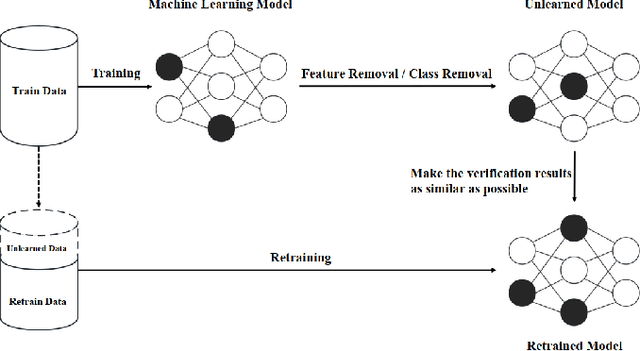
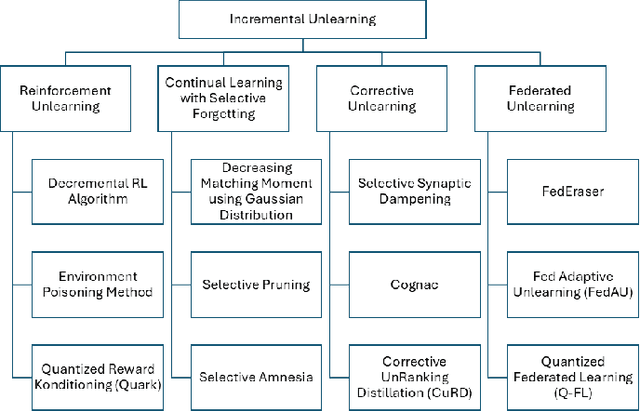
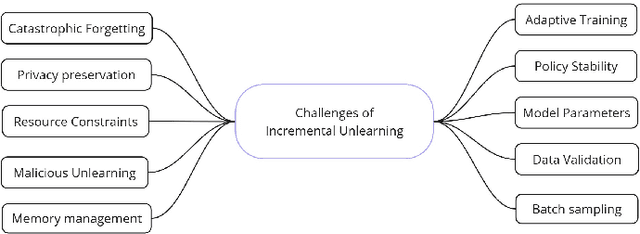
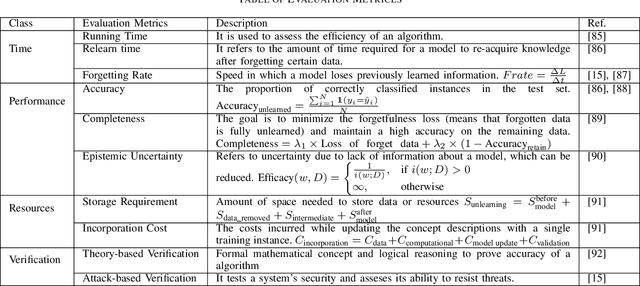
Abstract:The growing demand for data privacy in Machine Learning (ML) applications has seen Machine Unlearning (MU) emerge as a critical area of research. As the `right to be forgotten' becomes regulated globally, it is increasingly important to develop mechanisms that delete user data from AI systems while maintaining performance and scalability of these systems. Incremental Unlearning (IU) is a promising MU solution to address the challenges of efficiently removing specific data from ML models without the need for expensive and time-consuming full retraining. This paper presents the various techniques and approaches to IU. It explores the challenges faced in designing and implementing IU mechanisms. Datasets and metrics for evaluating the performance of unlearning techniques are discussed as well. Finally, potential solutions to the IU challenges alongside future research directions are offered. This survey provides valuable insights for researchers and practitioners seeking to understand the current landscape of IU and its potential for enhancing privacy-preserving intelligent systems.
CondAmbigQA: A Benchmark and Dataset for Conditional Ambiguous Question Answering
Feb 03, 2025



Abstract:Large language models (LLMs) are prone to hallucinations in question-answering (QA) tasks when faced with ambiguous questions. Users often assume that LLMs share their cognitive alignment, a mutual understanding of context, intent, and implicit details, leading them to omit critical information in the queries. However, LLMs generate responses based on assumptions that can misalign with user intent, which may be perceived as hallucinations if they misalign with the user's intent. Therefore, identifying those implicit assumptions is crucial to resolve ambiguities in QA. Prior work, such as AmbigQA, reduces ambiguity in queries via human-annotated clarifications, which is not feasible in real application. Meanwhile, ASQA compiles AmbigQA's short answers into long-form responses but inherits human biases and fails capture explicit logical distinctions that differentiates the answers. We introduce Conditional Ambiguous Question-Answering (CondAmbigQA), a benchmark with 200 ambiguous queries and condition-aware evaluation metrics. Our study pioneers the concept of ``conditions'' in ambiguous QA tasks, where conditions stand for contextual constraints or assumptions that resolve ambiguities. The retrieval-based annotation strategy uses retrieved Wikipedia fragments to identify possible interpretations for a given query as its conditions and annotate the answers through those conditions. Such a strategy minimizes human bias introduced by different knowledge levels among annotators. By fixing retrieval results, CondAmbigQA evaluates how RAG systems leverage conditions to resolve ambiguities. Experiments show that models considering conditions before answering improve performance by $20\%$, with an additional $5\%$ gain when conditions are explicitly provided. These results underscore the value of conditional reasoning in QA, offering researchers tools to rigorously evaluate ambiguity resolution.
Efficiently Integrate Large Language Models with Visual Perception: A Survey from the Training Paradigm Perspective
Feb 03, 2025



Abstract:The integration of vision-language modalities has been a significant focus in multimodal learning, traditionally relying on Vision-Language Pretrained Models. However, with the advent of Large Language Models (LLMs), there has been a notable shift towards incorporating LLMs with vision modalities. Following this, the training paradigms for incorporating vision modalities into LLMs have evolved. Initially, the approach was to integrate the modalities through pretraining the modality integrator, named Single-stage Tuning. It has since branched out into methods focusing on performance enhancement, denoted as Two-stage Tuning, and those prioritizing parameter efficiency, referred to as Direct Adaptation. However, existing surveys primarily address the latest Vision Large Language Models (VLLMs) with Two-stage Tuning, leaving a gap in understanding the evolution of training paradigms and their unique parameter-efficient considerations. This paper categorizes and reviews 34 VLLMs from top conferences, journals, and highly cited Arxiv papers, focusing on parameter efficiency during adaptation from the training paradigm perspective. We first introduce the architecture of LLMs and parameter-efficient learning methods, followed by a discussion on vision encoders and a comprehensive taxonomy of modality integrators. We then review three training paradigms and their efficiency considerations, summarizing benchmarks in the VLLM field. To gain deeper insights into their effectiveness in parameter efficiency, we compare and discuss the experimental results of representative models, among which the experiment of the Direct Adaptation paradigm is replicated. Providing insights into recent developments and practical uses, this survey is a vital guide for researchers and practitioners navigating the efficient integration of vision modalities into LLMs.
Text Data Augmentation for Large Language Models: A Comprehensive Survey of Methods, Challenges, and Opportunities
Jan 31, 2025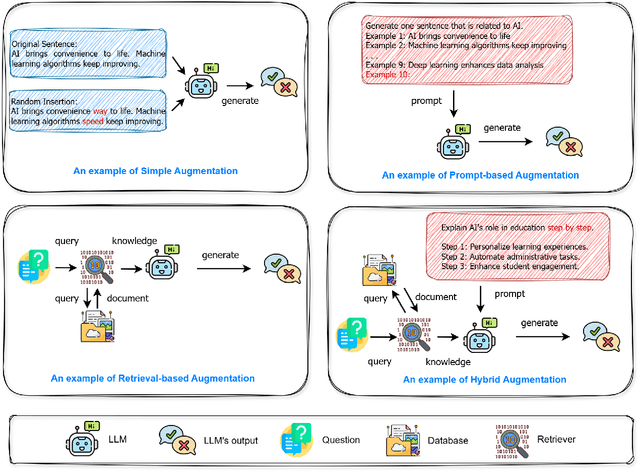
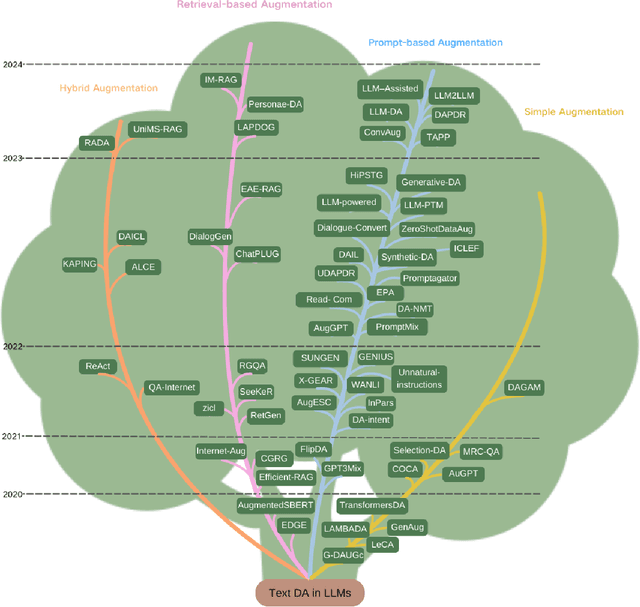
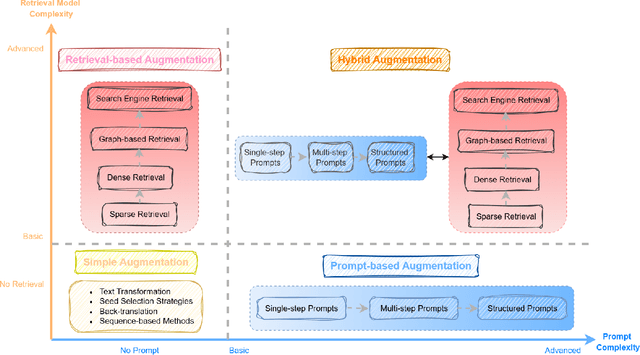
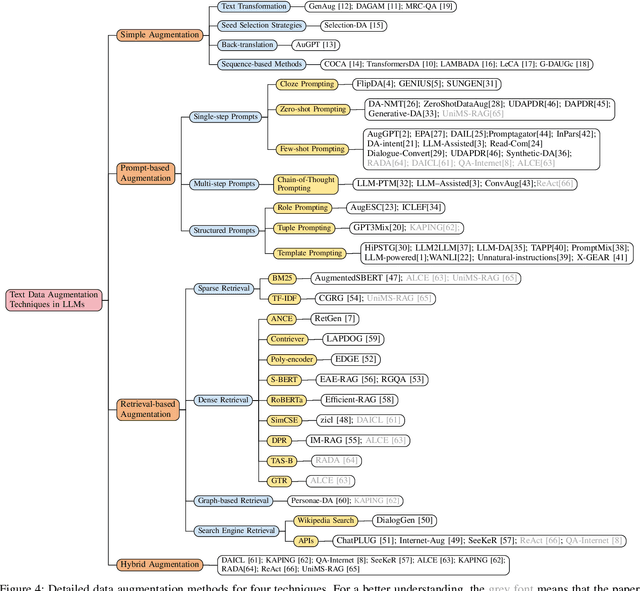
Abstract:The increasing size and complexity of pre-trained language models have demonstrated superior performance in many applications, but they usually require large training datasets to be adequately trained. Insufficient training sets could unexpectedly make the model overfit and fail to cope with complex tasks. Large language models (LLMs) trained on extensive corpora have prominent text generation capabilities, which improve the quality and quantity of data and play a crucial role in data augmentation. Specifically, distinctive prompt templates are given in personalised tasks to guide LLMs in generating the required content. Recent promising retrieval-based techniques further improve the expressive performance of LLMs in data augmentation by introducing external knowledge to enable them to produce more grounded-truth data. This survey provides an in-depth analysis of data augmentation in LLMs, classifying the techniques into Simple Augmentation, Prompt-based Augmentation, Retrieval-based Augmentation and Hybrid Augmentation. We summarise the post-processing approaches in data augmentation, which contributes significantly to refining the augmented data and enabling the model to filter out unfaithful content. Then, we provide the common tasks and evaluation metrics. Finally, we introduce existing challenges and future opportunities that could bring further improvement to data augmentation.
STAR: Stepwise Task Augmentation and Relation Learning for Aspect Sentiment Quad Prediction
Jan 27, 2025



Abstract:Aspect-based sentiment analysis (ABSA) aims to identify four sentiment elements, including aspect term, aspect category, opinion term, and sentiment polarity. These elements construct the complete picture of sentiments. The most challenging task, aspect sentiment quad prediction (ASQP), predicts these elements simultaneously, hindered by difficulties in accurately coupling different sentiment elements. A key challenge is insufficient annotated data that limits the capability of models in semantic understanding and reasoning about quad prediction. To address this, we propose stepwise task augmentation and relation learning (STAR), a strategy inspired by human reasoning. STAR constructs auxiliary data to learn quadruple relationships incrementally by augmenting with pairwise and overall relation tasks derived from training data. By encouraging the model to infer causal relationships among sentiment elements without requiring additional annotations, STAR effectively enhances quad prediction. Extensive experiments demonstrate the proposed STAR exhibits superior performance on four benchmark datasets.
LineArt: A Knowledge-guided Training-free High-quality Appearance Transfer for Design Drawing with Diffusion Model
Dec 16, 2024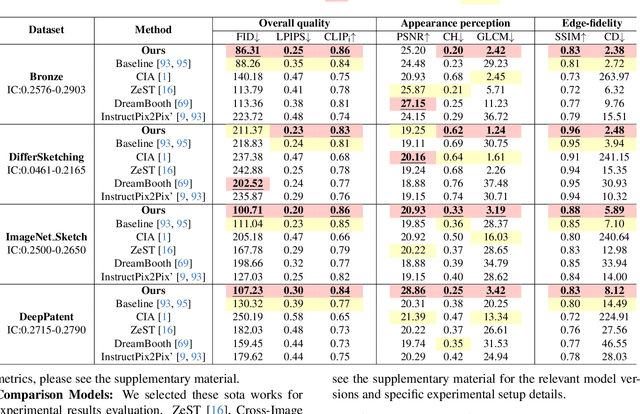
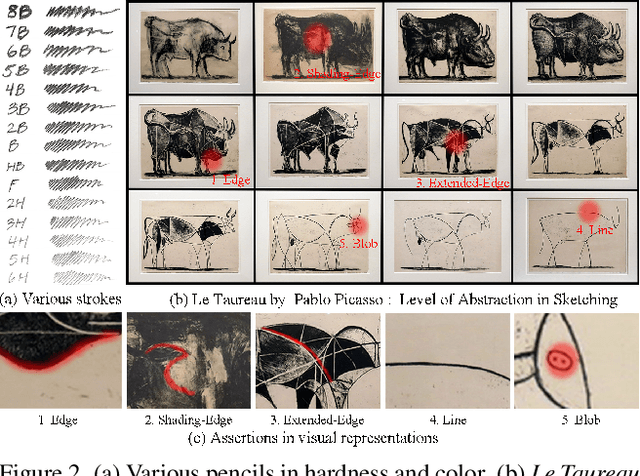

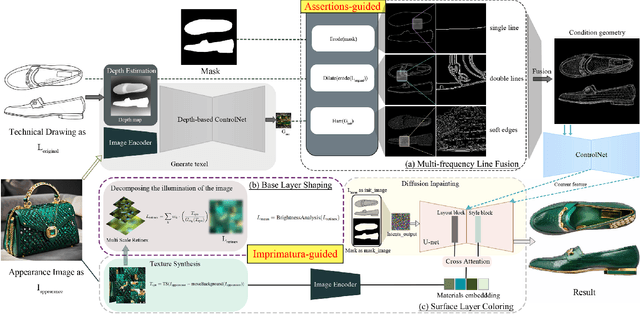
Abstract:Image rendering from line drawings is vital in design and image generation technologies reduce costs, yet professional line drawings demand preserving complex details. Text prompts struggle with accuracy, and image translation struggles with consistency and fine-grained control. We present LineArt, a framework that transfers complex appearance onto detailed design drawings, facilitating design and artistic creation. It generates high-fidelity appearance while preserving structural accuracy by simulating hierarchical visual cognition and integrating human artistic experience to guide the diffusion process. LineArt overcomes the limitations of current methods in terms of difficulty in fine-grained control and style degradation in design drawings. It requires no precise 3D modeling, physical property specs, or network training, making it more convenient for design tasks. LineArt consists of two stages: a multi-frequency lines fusion module to supplement the input design drawing with detailed structural information and a two-part painting process for Base Layer Shaping and Surface Layer Coloring. We also present a new design drawing dataset ProLines for evaluation. The experiments show that LineArt performs better in accuracy, realism, and material precision compared to SOTAs.
 Add to Chrome
Add to Chrome Add to Firefox
Add to Firefox Add to Edge
Add to Edge